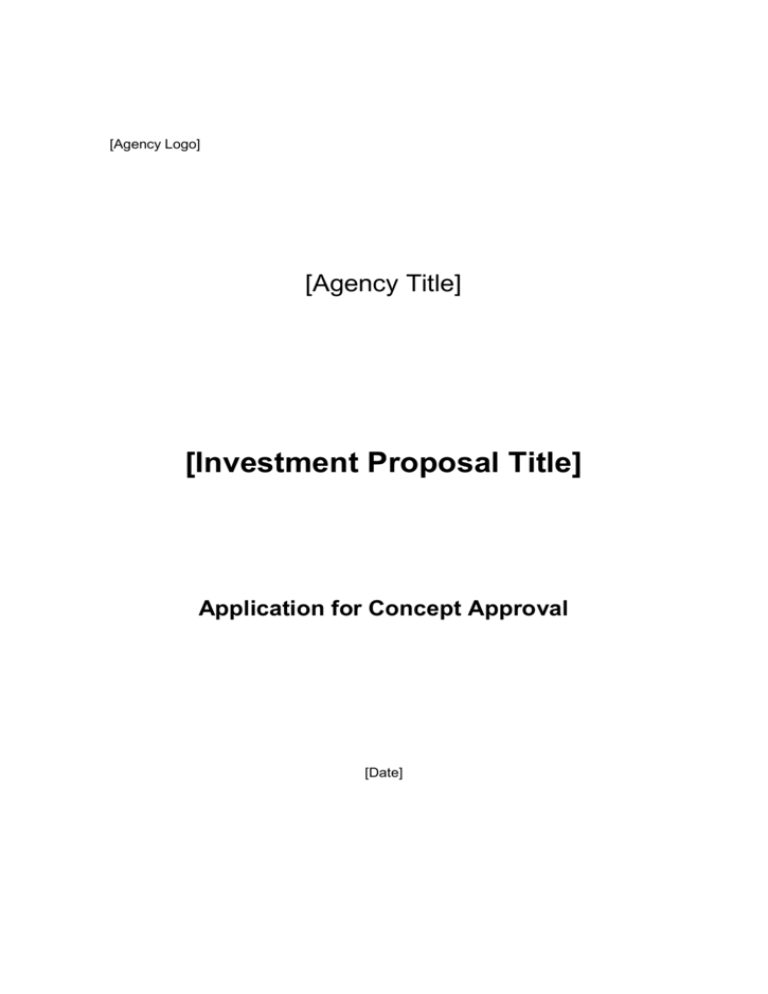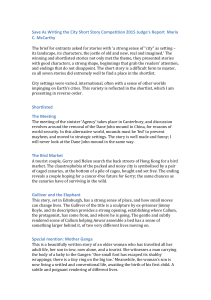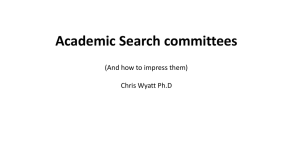Application for Concept Approval
advertisement

[Agency Logo] [Agency Title] [Investment Proposal Title] Application for Concept Approval [Date] Approval Name/Title Signature Date Minister Director General / Chief Executive Officer Chief Finance Officer Chief Information Officer Other Contact Officer Name/Title Email Phone Version Control Version Draft 1 Draft 2 Final Date Status/Action/Change Approved By Executive Summary This section outlines the purpose of the investment, the business problem that would be addressed, the pros and cons of the recommended and alternative options, and the key approvals and next steps. Clear advice is provided on: the most cost-effective investment option that would best serve the government’s policy, and an agency’s service delivery objectives; alternative options, should decision-makers conclude that the first option does not have priority for investment at the levels of expenditure and risk proposed, or should future financial, economic or other constraints preclude it; the benefits and the cost and risk profiles for the recommended and alternative options; and the next steps such as for agency resources to be allocated to prepare a detailed business case. The advice is presented in summary, rather than argued. The information in the remainder of the ACA provides the necessary justification. Statement of Purpose Strategic Justification This section demonstrates that the investment proposal has a strong business objective and high relative priority. The main points of reference are the Government policies, demand drivers and projections, and the service delivery objectives and model in an agency’s Strategic Asset Plan (SAP). The ACA does not repeat the detail to be found in the SAP – but a clear, direct link to the relevant elements is shown. Question What ranking does the proposal have in the list of highest priority, longer-term investment items at the conclusion of the SAP? 1 Existing Assets This section clarifies the weaknesses and strengths in an agency’s existing asset base and future service capacity that the investment proposal would address. The point of reference is the Current Review section in the SAP. The gap analysis covers the limitations and significant risks to service delivery caused by weaknesses in both existing assets, and related non asset initiatives. The focus of the gap analysis is not solely on weaknesses – it also identifies strengths that could be built upon to help address the gap. Questions Which of the highest priority service delivery gaps and risks would the proposal address? What are the strengths of the existing assets (and non-asset initiatives) upon which future capacity could be built? Investment Proposal This section provides a concise statement of the objectives and benefits, including the levels of improved functionality and performance that the investment proposal would aim to achieve. The statement of benefit and the performance measures are focused on the broad investment proposal in an agency’s SAP (not on the alternative options that might be used to achieve it). This is done in dot point form on a single page which lists, for example, the percentage increase in a service per hour to the public, or in the availability of that service, or the speed at which an agency could respond. The benefits statement is practical, with measurable performance indicators. Examples include: 2 improving emergency response times in given suburb from thirty to twenty minutes; consolidating multiple, on-line public information sites to a central, easy access portal; and increasing positive stakeholder or user satisfaction feedback by X% in year one. A well-constructed statement builds on the strengths in an agency’s existing assets (identified in the preceding ACA section), establishes a clear requirement for the proposal (in the context of related proposals and approved projects) and clarifies the main aspects that would be outside the scope of the proposal. Questions How would the proposed investment help to meet the service delivery objectives, and form part of the service delivery model in the SAP? What practical impact would the proposal have at the particular community level and among other users who would benefit? Why are each of the benefits and performance measures realistic and achievable? Options Shortlist Description This section describes each of the shortlisted options that are most likely to provide value for money in achieving the objectives, benefits and performance measures for the investment proposal. In most cases, the shortlist will contain at least three options: continuation of the status quo: including the benefits, costs and risks inherent in this approach (for example, for increased maintenance and staffing); first alternative: which would enable transition from the status quo to a satisfactory level of improved service – focused on the essential, highest priority objectives and benefits, rather than those that may be desirable or ideal; and other alternatives: which would substantially improve services to meet the highest levels of demand, and achieve all or most of the objectives and benefits of the investment proposal. The shortlist may include a mix of current asset optimisation, non-asset initiatives and new investment, whether major or minor, as appropriate to the circumstances for the proposal. The shortlist should not provide an argument for a single option by emphasising only its strengths and the weaknesses of the alternatives. Sufficient, concise advice is provided to demonstrate that the highest ranked options that were excluded from the shortlist were rejected objectively, due to their weaker relative merit and value for money potential. 3 Questions To what extent would each shortlisted option address each of the highest priority service delivery objectives, benefits and gaps? What are the weaknesses, limitations and risks of each shortlisted option? Why were the other options in the long list rejected, particularly those with highest ranking? Value for Money Comparison This section clarifies the parameters for each of the shortlisted options, and compares their relative value for money potential. The objective is to clarify the relative advantages and disadvantages of each option in terms of the scope and benefits that could be achieved, at a given cost, and at the earliest time at manageable risk. It is important to emphasise that the recommended option is an outcome from this evaluation, not a favoured input. Scope What is the scope of each option? Why is the scope appropriate and not excessive in addressing future service delivery demand drivers and projections? Would any shortfalls in scope be material to the success of the proposal? Which options provide the best opportunities to promote inter-agency efficiency, for example through the shared use or development of existing or future information technology systems or support? Why should the status quo not continue – why do the costs and risks of this option outweigh the benefits relative to other options? Existing Asset Optimisation 4 Which options make best use of existing assets? Do any of the options waste or duplicate existing assets? What would be done with the existing asset? Why would the most cost-effective way ahead not be to invest solely in sustaining current assets? Non-Asset Initiatives Which options make best use of current or new non-asset initiatives? Why would the most cost-effective way ahead not be solely to invest in non-asset initiatives? Benefits What are the top three, practical benefits that would be achieved by each option in terms of service delivery, stakeholder expectations and the efficiency of the public service? Why are the top benefits worth the price that would be paid to achieve them? Cost/Contingency What are the top five cost drivers for each option? What are the best and worst case total indicative cost estimates (including the contingency element, calibrated to address the risks)? What are the indicative operating costs? How much would costs have to increase before the option would no longer provide value for money? Schedule When would each option start to deliver services – based on a realistic appraisal of the scope and risks involved? Which option offers the best early benefits realisation based on prudent planning and implementation? How would the schedule enable a gradual, incremental approach to achieving the benefits – as distinct from a big bang, high risk approach? 5 Finance and Procurement What are the potential financing and procurement methods that could be used given the nature and scale of the proposal (e.g. traditional; public private partnership; collaborative contracting)? Could the proposal be included in whole-of-government or agency planning to establish procurement efficiencies, for example through the bundling of related contracts? Could the proposal form part of a long-term infrastructure investment plan at State or Commonwealth level? Risk Mitigation What are the major risks faced by each option, in terms of: delivery on time, cost and schedule; benefits realisation; and overall value for money – including, for example, risks from stakeholder opposition, land assembly approvals, the complexity of the technology involved or the lack of workforce skills and numbers? What action would be taken to address each major risk? What unintended negative consequences could arise, and how will they be avoided or minimised? After taking risk mitigation into account, what overall risk rating should be allocated to each option (high, medium, low) and why? Recommendations Based on the above value for money comparison, this section recommends the best and alternative options, and outlines the implementation issues involved. Examples of significant implementation issues include: the governance and accountability system that would be established in an agency (and with related agencies); and any resource or capacity constraints for which planning and corrective action would be required, if the proposal is supported for further development in a business case. Options 6 Which of the shortlisted options is the recommended one, and why? Which are the next best, alternative options, and why do they offer less value for money than the recommended one? What level of indicative funding should be allocated in the out-years 5-10 of the State’s Asset Investment Program to cover the recommended and alternative options (as shown at Appendix A)? 7 Appendix A: Total Financial Impact 1. Proposal Title: a. Type: [e.g. new asset; upgrade; asset disposal?] b. Location: [latitude/longitude] 2. Financing Method: [e.g. private sector; agency borrowing; Commonwealth] 3. Net Debt Impact: 4. Planning Funds for Business Case Required? 5. Total initial estimate (beyond the forward estimates): Year [insert relevant] Initial Project Cashflows Capital Cost Less Other Funding Consolidated Account Estimate Recurrent Impact Asset Maintenance Depreciation Borrowing Costs FTE Costs Other Sub-Total Less: Existing Funding Less: Revenue Net Recurrent Impact 8 [FE plus 1] [FE plus 2] [FE plus 3] [FE plus 4] [FE plus 5] Longerterm








